belt MAZDA MODEL 3 HATCHBACK 2020 (in English) Owner's Manual
[x] Cancel search | Manufacturer: MAZDA, Model Year: 2020, Model line: MODEL 3 HATCHBACK, Model: MAZDA MODEL 3 HATCHBACK 2020Pages: 598, PDF Size: 89.37 MB
Page 47 of 598
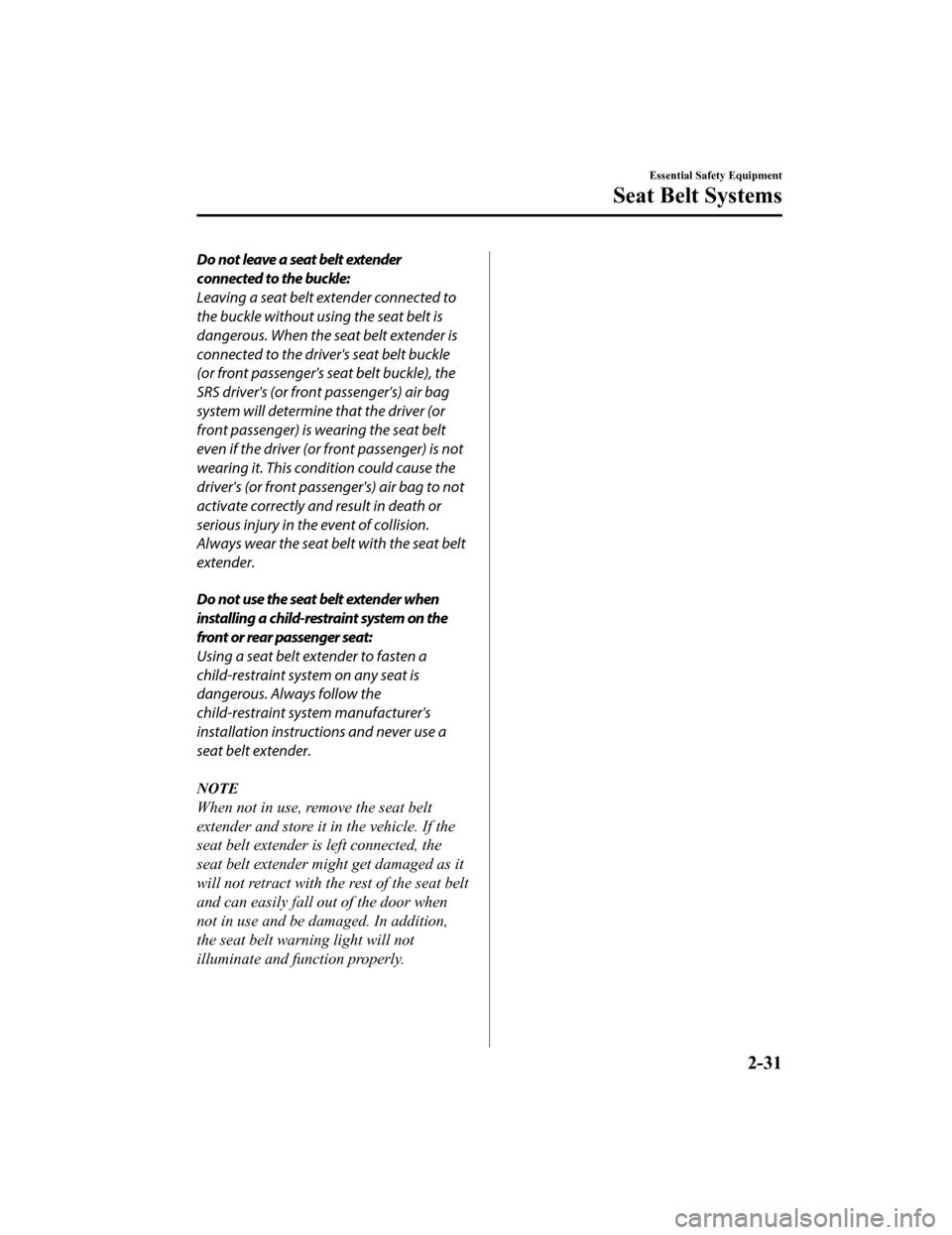
Do not leave a seat belt extender
connected to the buckle:
Leaving a seat belt extender connected to
the buckle without using the seat belt is
dangerous. When the seat belt extender is
connected to the driver's seat belt buckle
(or front passenger's seat belt buckle), the
SRS driver's (or front passenger's) air bag
system will determine that the driver (or
front passenger) is wearing the seat belt
even if the driver (or front passenger) is not
wearing it. This condition could cause the
driver's (or front passenger's) air bag to not
activate correctly and result in death or
serious injury in the event of collision.
Always wear the seat belt with the seat belt
extender.
Do not use the seat belt extender when
installing a child-restraint system on the
front or rear passenger seat:
Using a seat belt extender to fasten a
child-restraint system on any seat is
dangerous. Always follow the
child-restraint system manufacturer's
installation instructions and never use a
seat belt extender.
NOTE
When not in use, remove the seat belt
extender and store it in the vehicle. If the
seat belt extender is left connected, the
seat belt extender might get damaged as it
will not retract with the rest of the seat belt
and can easily fall out of the door when
not in use and be damaged. In addition,
the seat belt warning light will not
illuminate and function properly.
Essential Safety Equipment
Seat Belt Systems
2-31
Mazda3_8HZ1-EA-19G_Edition1_old2019-5-17 13:49:03
Page 48 of 598
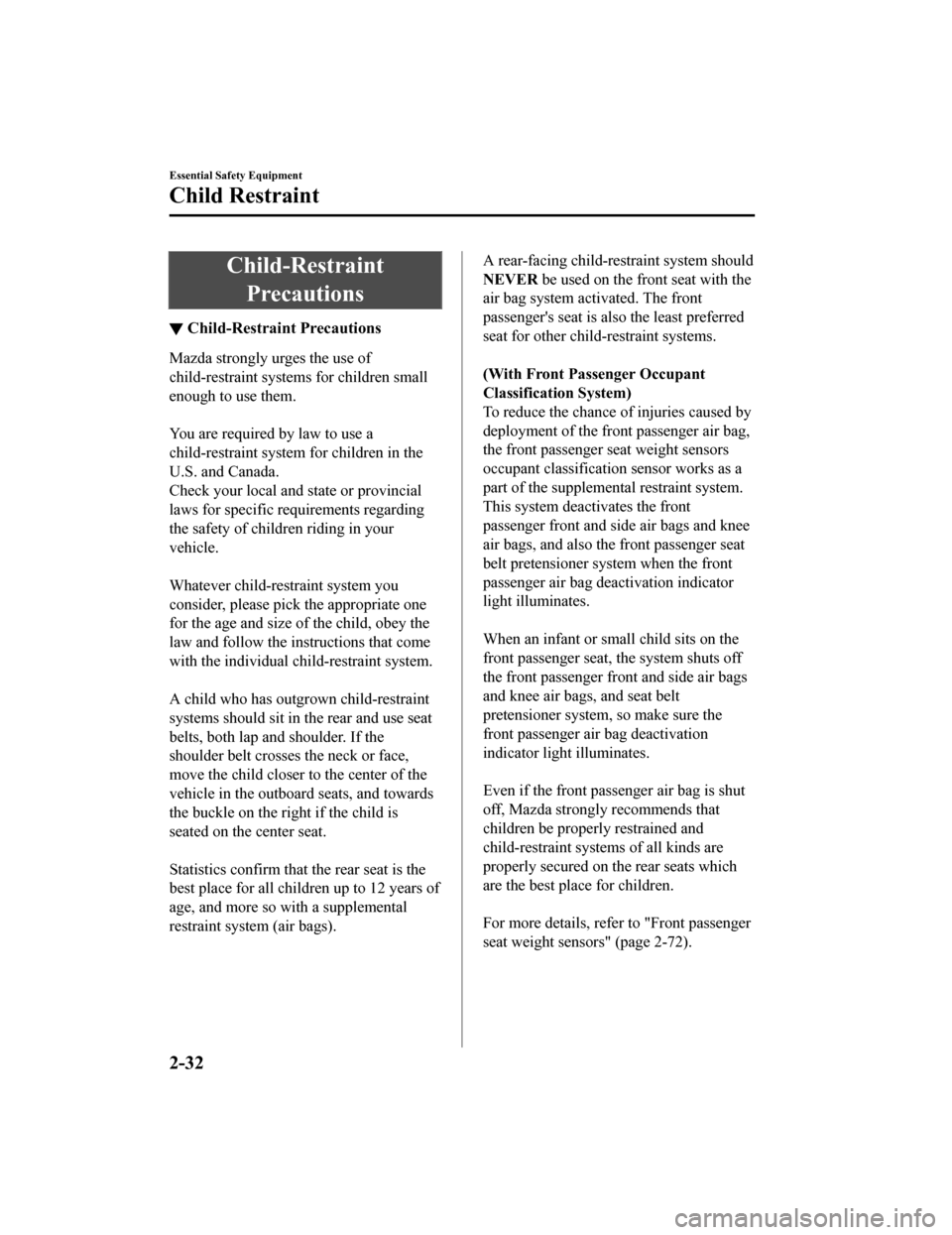
Child-RestraintPrecautions
▼ Child-Restraint Precautions
Mazda strongly urges the use of
child-restraint system
s for children small
enough to use them.
You are required by law to use a
child-restraint system for children in the
U.S. and Canada.
Check your local and state or provincial
laws for specific requirements regarding
the safety of childr en riding in your
vehicle.
Whatever child-rest raint system you
consider, please pick the appropriate one
for the age and size of the child, obey the
law and follow the i nstructions that come
with the individual ch ild-restraint system.
A child who has outgrown child-restraint
systems should sit in the rear and use seat
belts, both lap an d shoulder. If the
shoulder belt crosses the neck or face,
move the child closer to the center of the
vehicle in the outboard seats, and towards
the buckle on the right if the child is
seated on the center seat.
Statistics confirm that the rear seat is the
best place for all children up to 12 years of
age, and more so with a supplemental
restraint system (air bags).
A rear-facing child-restraint system should
NEVER be used on the front seat with the
air bag system activated. The front
passenger's seat is also the least preferred
seat for other child-restraint systems.
(With Front Passenger Occupant
Classification System)
To reduce the chance of injuries caused by
deployment of the front passenger air bag,
the front passenger seat weight sensors
occupant classification sensor works as a
part of the supplementa l restraint system.
This system deactivates the front
passenger front and side air bags and knee
air bags, and also the front passenger seat
belt pretensioner system when the front
passenger air bag deactivation indicator
light illuminates.
When an infant or small child sits on the
front passenger seat, the system shuts off
the front passenger front and side air bags
and knee air bags, and seat belt
pretensioner system, so make sure the
front passenger air bag deactivation
indicator light illuminates.
Even if the front passenger air bag is shut
off, Mazda strongly recommends that
children be prope rly restrained and
child-restraint systems of all kinds are
properly secured on the rear seats which
are the best place for children.
For more details, refer to "Front passenger
seat weight sensors" (page 2-72).
Essential Safety Equipment
Child Restraint
2-32
Mazda3_8HZ1-EA-19G_Edition1_old 2019-5-17 13:49:03
Page 49 of 598
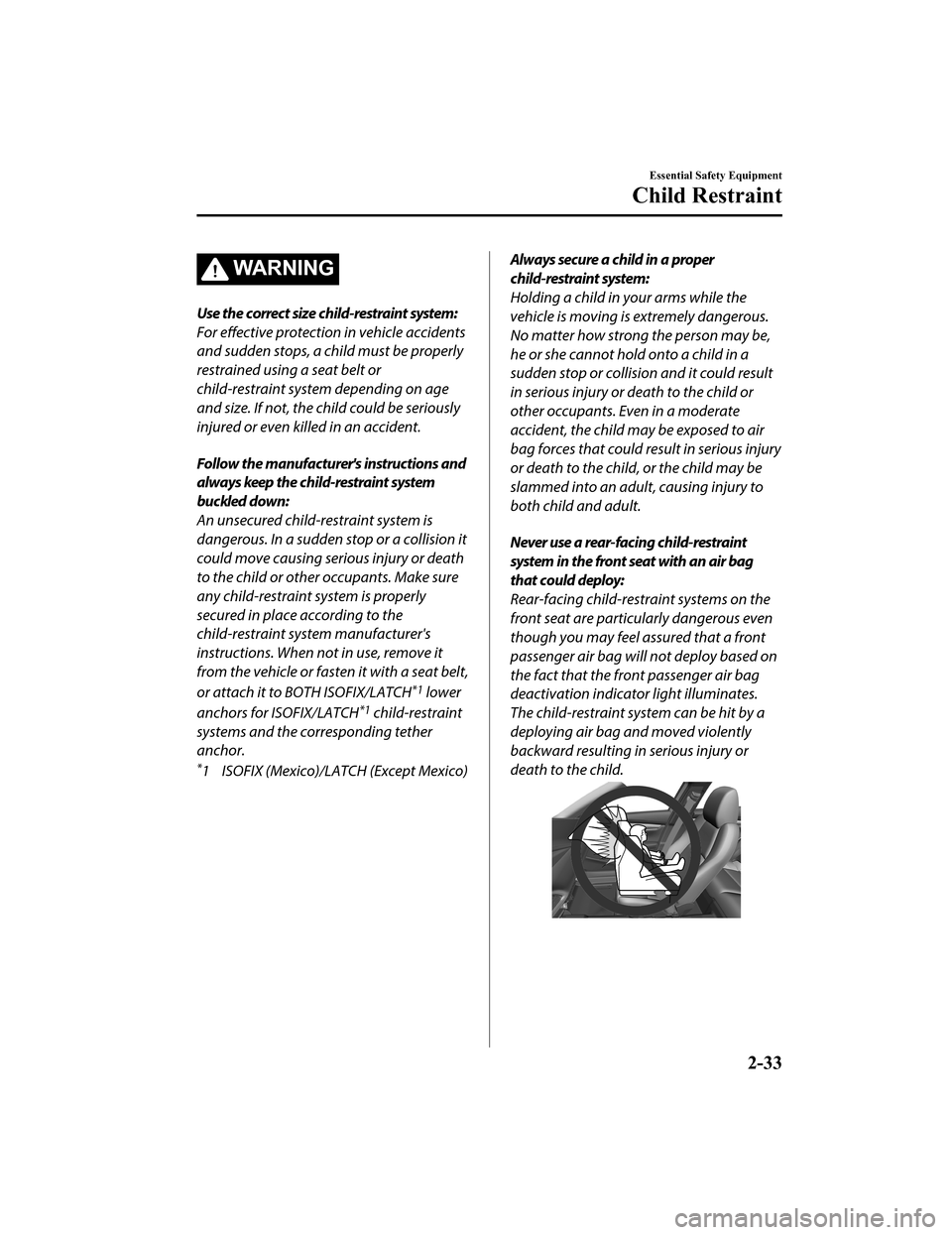
WA R N I N G
Use the correct size child-restraint system:
For effective protection in vehicle accidents
and sudden stops, a child must be properly
restrained using a seat belt or
child-restraint system depending on age
and size. If not, the child could be seriously
injured or even killed in an accident.
Follow the manufacturer's instructions and
always keep the child-restraint system
buckled down:
An unsecured child-restraint system is
dangerous. In a sudden stop or a collision it
could move causing serious injury or death
to the child or other occupants. Make sure
any child-restraint system is properly
secured in place according to the
child-restraint system manufacturer's
instructions. When not in use, remove it
from the vehicle or fasten it with a seat belt,
or attach it to BOTH ISOFIX/LATCH
*1 lower
anchors for ISOFIX/LATCH
*1 child-restraint
systems and the corresponding tether
anchor.
*1 ISOFIX (Mexico)/LATCH (Except Mexico)
Always secure a child in a proper
child-restraint system:
Holding a child in your arms while the
vehicle is moving is extremely dangerous.
No matter how strong the person may be,
he or she cannot hold onto a child in a
sudden stop or collision and it could result
in serious injury or death to the child or
other occupants. Even in a moderate
accident, the child may be exposed to air
bag forces that could result in serious injury
or death to the child, or the child may be
slammed into an adult, causing injury to
both child and adult.
Never use a rear-facing child-restraint
system in the front seat with an air bag
that could deploy:
Rear-facing child-restraint systems on the
front seat are particularly dangerous even
though you may feel assured that a front
passenger air bag will not deploy based on
the fact that the front passenger air bag
deactivation indicator light illuminates.
The child-restraint system can be hit by a
deploying air bag and moved violently
backward resulting in serious injury or
death to the child.
Essential Safety Equipment
Child Restraint
2-33
Mazda3_8HZ1-EA-19G_Edition1_old 2019-5-17 13:49:03
Page 51 of 598
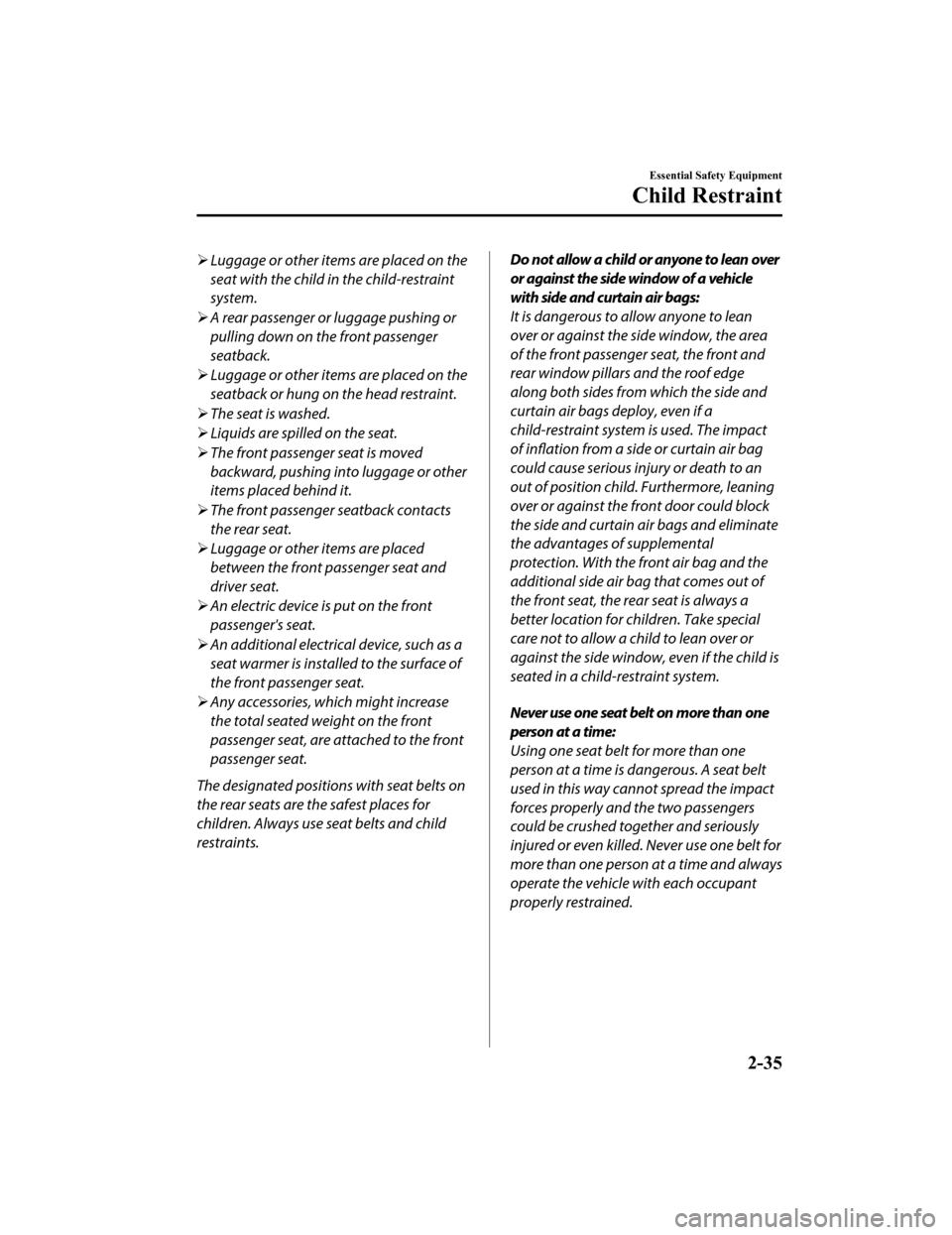
Luggage or other items are placed on the
seat with the child in the child-restraint
system.
A rear passenger or luggage pushing or
pulling down on the front passenger
seatback.
Luggage or other items are placed on the
seatback or hung on the head restraint.
The seat is washed.
Liquids are spilled on the seat.
The front passenger seat is moved
backward, pushing into luggage or other
items placed behind it.
The front passenger seatback contacts
the rear seat.
Luggage or other items are placed
between the front passenger seat and
driver seat.
An electric device is put on the front
passenger's seat.
An additional electrical device, such as a
seat warmer is installed to the surface of
the front passenger seat.
Any accessories, which might increase
the total seated weight on the front
passenger seat, are attached to the front
passenger seat.
The designated positions with seat belts on
the rear seats are the safest places for
children. Always use seat belts and child
restraints.Do not allow a child or anyone to lean over
or against the side window of a vehicle
with side and curtain air bags:
It is dangerous to allow anyone to lean
over or against the side window, the area
of the front passenger seat, the front and
rear window pillars and the roof edge
along both sides from which the side and
curtain air bags deploy, even if a
child-restraint system is used. The impact
of inflation from a side or curtain air bag
could cause serious injury or death to an
out of position child. Furthermore, leaning
over or against the front door could block
the side and curtain air bags and eliminate
the advantages of supplemental
protection. With the front air bag and the
additional side air bag that comes out of
the front seat, the rear seat is always a
better location for children. Take special
care not to allow a child to lean over or
against the side window, even if the child is
seated in a child-restraint system.
Never use one seat belt on more than one
person at a time:
Using one seat belt for more than one
person at a time is dangerous. A seat belt
used in this way cannot spread the impact
forces properly and the two passengers
could be crushed together and seriously
injured or even killed. Never use one belt for
more than one person at a time and always
operate the vehicle with each occupant
properly restrained.
Essential Safety Equipment
Child Restraint
2-35
Mazda3_8HZ1-EA-19G_Edition1_old 2019-5-17 13:49:03
Page 52 of 598

CAUTION
A seat belt or child-restraint system can
become very hot in a closed vehicle during
warm weather. To avoid burning yourself
or a child, check them before you or your
child touches them.
NOTE
Your Mazda is equipped with ISOFIX/
LATCH
*1 lower anchors for attachment of
specially design ed ISOFIX/LATCH
*1
child-restraint systems on the rear seats.
When using these anchors to secure a
child-restraint system, refer to "Using
ISOFIX Lower Anchor (Mexico)/Using
LATCH Lower Anchor (Except Mexico)"
(page 2-50).
*1 ISOFIX (Mexico)/LATCH (Except
Mexico)
Essential Safety Equipment
Child Restraint
2-36
Mazda3_8HZ1-EA-19G_Edition1_old 2019-5-17 13:49:03
Page 54 of 598

Due to variations in the design of
child-restraint systems, vehicle seats
and seat belts, all child-restraint systems
may not fit all seating positions. Before
purchasing a child-restraint system, it
should be tested in the specific vehicle
seating position (or positions) where it
is intended to be used. If a previously
purchased child-restraint system does
not fit, you may need to purchase a
different one that will.
Infant seat
An infant seat provides restraint by
bracing the infant's head, neck and back
against the seating surface.
Equal to Group 0 and 0+ of the UN-R 44
and UN-R 129 regulation.
Child seat
A child seat restrains a child's body using
the harness.
Equal to Group 1 o f the UN-R 44 and
UN-R 129 regulation.
Booster seat
A booster seat is a child restraint
accessory designed to improve the fit of
the seat belt system around the child's
body.
Equal to Group 2 and 3 of the UN-R 44
and UN-R 129 regulation.
1. Full booster seat
2. Backless booster seat
When using a backless booster seat,
always install the vehicle head restraint to
the seat where the backless booster seat is
installed.
Essential Safety Equipment
Child Restraint
2-38
Mazda3_8HZ1-EA-19G_Edition1_old 2019-5-17 13:49:03
Page 55 of 598

Child-Restraint System Suitability for Various Seat
Positions Table
▼ Child-Restraint System Suitability
for Various Seat Positions Table
(Mexico)
Provided information in the tabl e shows your child-restraint system suitability for various
seating position. For installation suitability of other manufac turer child-restraint system,
carefully consult the manufacture r's instructions which accompany the child-restraint
system.
When installing a child-restraint system, the following points must be observed:
Always remove the head restraint before installing a child-restraint system. However,
when installing a backless booster seat, always install the veh icle head restraint to the seat
where the backless booster seat is installed. In addition, alwa ys use a tether strap and
attach it securely. Refer to H ead Restraints on page 2-17.
When installing a child-restrain t system to the front passenger seat, adjust the seat slide
position as far back as possible.
Refer to Adjusting the Front Passenger's Seat on page 2-13.
When it is difficult to install a child-restraint system to the front passenger seat, or the seat
belt cannot be secured to the ch ild-restraint system, perform the following operations to
adjust the seat holding the child-restraint system so that the seat belt can be secured
completely to it.
Move the seat forward or back.
Move the seatback forward or back.
Move the seat upward or downward. (Vehicles with height adjustm ent function)
When installing a child-restraint system to the rear seat, adjust the front seat position so
that the front seat does not contact the child-restraint system .
Refer to Adjusting the Driver's Seat on page 2-5.
Refer to Adjusting the Front Passenger's Seat on page 2-13.
When installing a child-restrain t system equipped with a tether, remove the head restraint.
Refer to Head Restraints on page 2-17.
An i-Size child-restra int system refers to a child-restraint sy stem which has acquired
i-Size category certification fo r the UN-R 129 regulation.
When installing a child-restraint system to the rear seat, refer to the child-restraint system
manufacturer's instructions and the Using ISOFIX Lower Anchor o n page 2-50.
Seating position Passenger Rear (Left) Rear (Center) Rear (Right)
Seating position suit‐
able for universal
belted (Yes/No) Ye s ( U F )
Ye s ( U )Ye s ( U )Ye s ( U )
Essential Safety Equipment
Child Restraint
2-39
Mazda3_8HZ1-EA-19G_Edition1_old 2019-5-17 13:49:03
Page 60 of 598

(5–Door)
1. Tether strap
2. Anchor bracket
3. Forward
Always install the head restraint and adjust
it to the appropriate position after
removing the child-restraint system:
Driving with the head restraint removed is
dangerous as impact to the occupant's
head cannot be prevented during
emergency braking or in a collision, which
could result in a serious accident, injury or
death.
Refer to Head Restraints on page 2-17.
▼Using Automatic Locking Mode
(Except Mexico)
Follow these instructions when using a
child-restraint system, unless you are
attaching a LATCH-equipped
child-restraint syst
em to the rear LATCH
lower anchors. Refer to “Using LATCH
Lower Anchor” (page 2-50).
NOTE
Follow the child- restraint system
manufacturer's instructions carefully. If
you are not sure whether you have a
LATCH system or tether, check in the
child-restraint system manufacturer's
instructions and follow them accordingly.
Depending on the type of child-restraint
system, it may use LATCH system instead
of seat belts or if the belt goes across the
child's chest, may recommend against
using automatic locking mode.
1. Make sure the seatback is securely latched by pushing it back until it is
fully locked.
2. Remove the head restraint. However,
when installing a backless booster seat,
always install the vehicle head restraint
to the seat where the backless booster
seat is installed.
Refer to Head Restraints on page 2-17.
3. Secure the child-restraint system with the lap portion of the lap/shoulder belt.
See the manufacturer's instructions on
the child-restraint system for belt
routing instructions.
Essential Safety Equipment
Child Restraint
2-44
Mazda3_8HZ1-EA-19G_Edition1_old 2019-5-17 13:49:03
Page 61 of 598

4. To get the retractor into the automaticlocking mode, pull the shoulder belt
portion of the seat belt until the entire
length of the belt is out of the retractor.
5. Push the child-restraint system firmlyinto the vehicle seat. Be sure the belt
retracts as snugly as possible. A
clicking noise from the retractor will
be heard during retraction if the system
is in the automatic locking mode. If the
belt does not lock the seat down tight,
repeat this step.
NOTE
Inspect this function before each use
of the child-restraint system. You
should not be able to pull the
shoulder belt out of the retractor
while the system is in the automatic
locking mode. When you remove the
child-restraint system, be sure the
belt fully retracts to return the
system to emergency locking mode
before occupants use the seat belts.
6. If your child-restraint system requires the use of a tether strap, refer to the
manufacturer's instructions to hook
and tighten the tether strap.
WA R N I N G
Use the tether and tether anchor only for a
child-restraint system:
Using the tether or tether anchor to secure
anything but a child-restraint system is
dangerous. This could weaken or damage
the tether or tether anchor and result in
injury.
Always remove the head restraint and
install child-restraint system (except when
installing a backless booster seat):
Installing a child-restraint system without
removing the head restraint is dangerous.
The child-restraint system cannot be
installed correctly which may result in
death or injury to the child in a collision.
Essential Safety Equipment
Child Restraint
2-45
Mazda3_8HZ1-EA-19G_Edition1_old 2019-5-17 13:49:03
Page 63 of 598
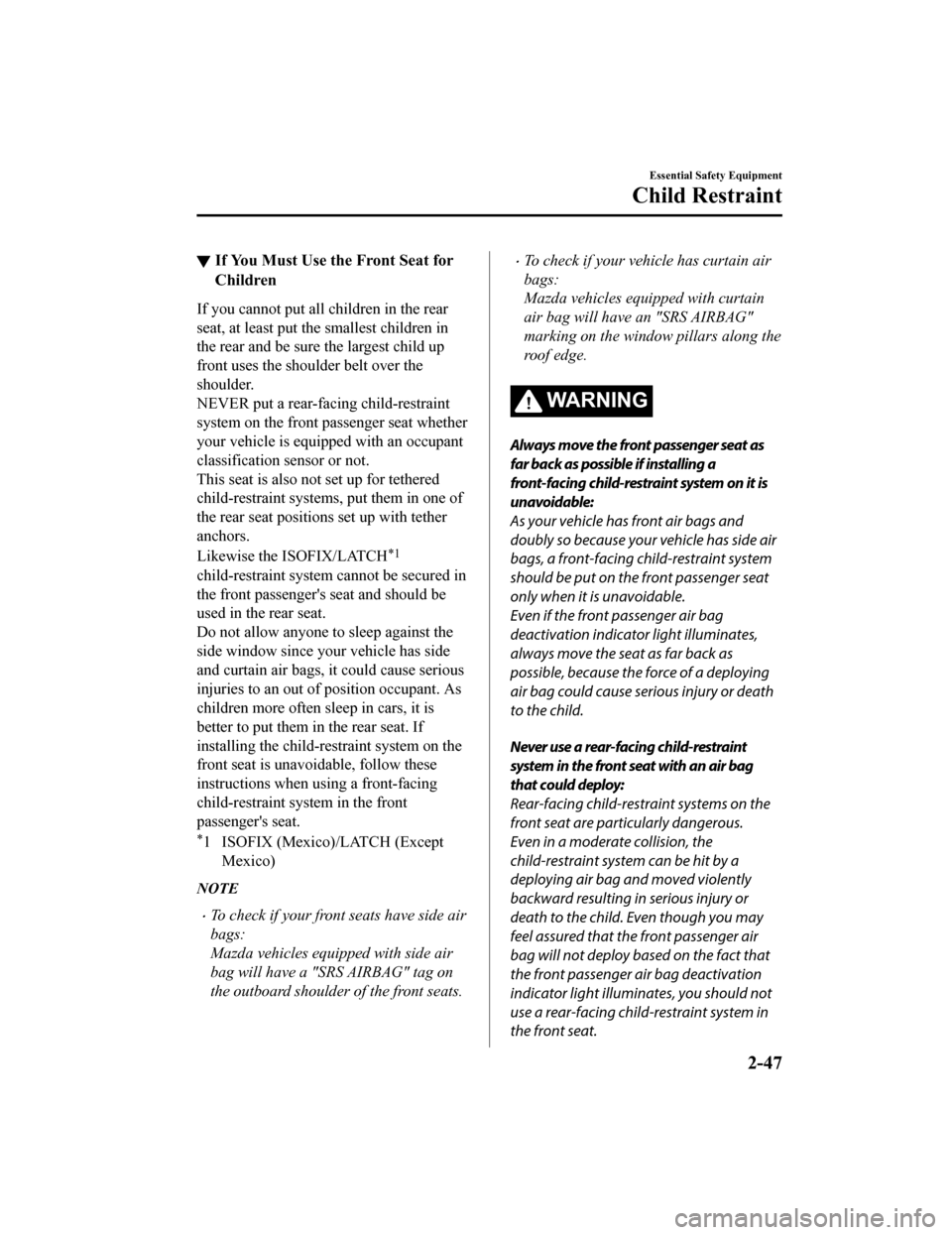
▼If You Must Use th
e Front Seat for
Children
If you cannot put all children in the rear
seat, at least put the smallest children in
the rear and be sure the largest child up
front uses the shou lder belt over the
shoulder.
NEVER put a rear-fac ing child-restraint
system on the front passenger seat whether
your vehicle is equipped with an occupant
classification sensor or not.
This seat is also not set up for tethered
child-restraint systems, put them in one of
the rear seat positions set up with tether
anchors.
Likewise the ISOFIX/LATCH
*1
child-restraint system cannot be secured in
the front passenger's seat and should be
used in the rear seat.
Do not allow anyone to sleep against the
side window since your vehicle has side
and curtain air bags, it could cause serious
injuries to an out of position occupant. As
children more often sleep in cars, it is
better to put them in the rear seat. If
installing the child-restraint system on the
front seat is unavoidable, follow these
instructions when using a front-facing
child-restraint system in the front
passenger's seat.
*1 ISOFIX (Mexico)/LATCH (Except Mexico)
NOTE
To check if your front seats have side air
bags:
Mazda vehicles equipped with side air
bag will have a "SRS AIRBAG" tag on
the outboard shoulder of the front seats.
To check if your vehicle has curtain air
bags:
Mazda vehicles equipped with curtain
air bag will have an "SRS AIRBAG"
marking on the window pillars along the
roof edge.
WA R N I N G
Always move the front passenger seat as
far back as possible if installing a
front-facing child-restraint system on it is
unavoidable:
As your vehicle has front air bags and
doubly so because your vehicle has side air
bags, a front-facing child-restraint system
should be put on the front passenger seat
only when it is unavoidable.
Even if the front passenger air bag
deactivation indicator light illuminates,
always move the seat as far back as
possible, because the force of a deploying
air bag could cause serious injury or death
to the child.
Never use a rear-facing child-restraint
system in the front seat with an air bag
that could deploy:
Rear-facing child-restraint systems on the
front seat are particularly dangerous.
Even in a moderate collision, the
child-restraint system can be hit by a
deploying air bag and moved violently
backward resulting in serious injury or
death to the child. Even though you may
feel assured that the front passenger air
bag will not deploy based on the fact that
the front passenger air bag deactivation
indicator light illuminates, you should not
use a rear-facing child-restraint system in
the front seat.
Essential Safety Equipment
Child Restraint
2-47
Mazda3_8HZ1-EA-19G_Edition1_old 2019-5-17 13:49:03